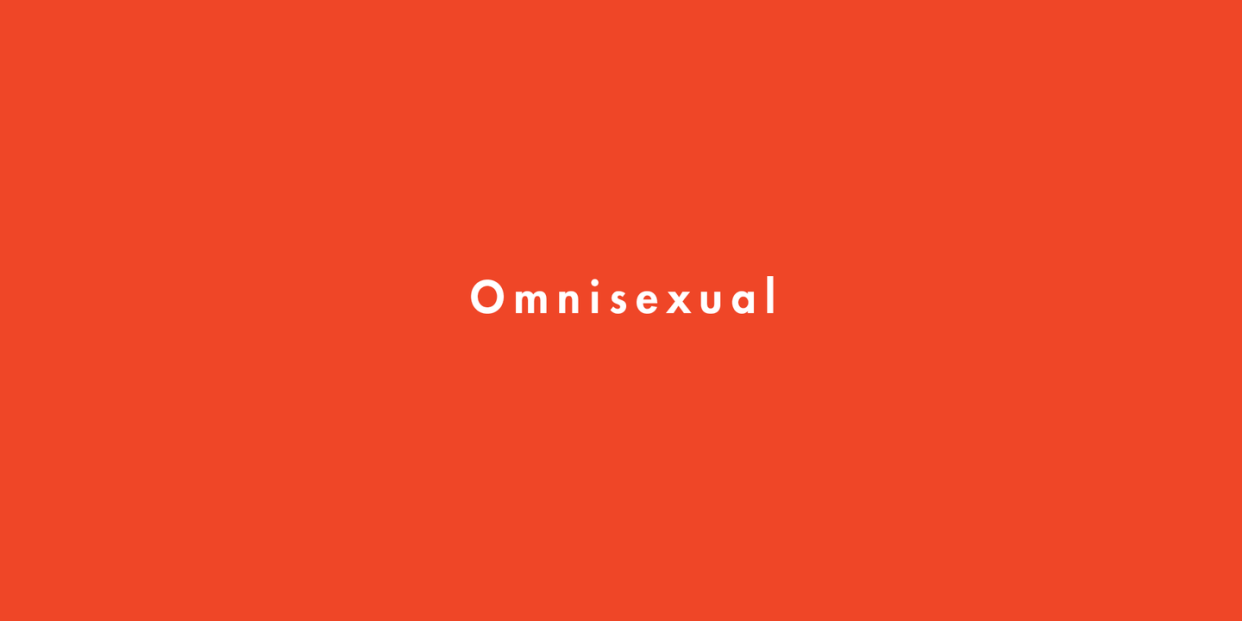Let’s Talk About What It Means to Be Omnisexual

“Omnisexual” is one of many terms that can be used to describe someone’s sexual orientation—aka who someone is romantically and/or sexually attracted to, says LGBTQ+ expert Kyle Elliott, founder and career coach at Caffeinated Kyle. It is along the same spectrum that “queer,” “lesbian,” “gay,” “bisexual,” “pansexual,” and more can fall on.
As for a definition, “omnisexual” just means that someone can find themselves attracted to all people, regardless of their gender. Because remember, there’s a difference between someone’s sexual orientation, which is who they are or aren’t attracted to, and gender identity, which is how someone experiences and defines their gender internally, says Elliott.
If you need a helpful way to remember “omnisexual” and its definition, take a trip back to middle school and remember that the root “omni” means “each and every one.” So, again, people who identify as omnisexual can find themselves attracted to each and every person, no matter their gender identity or gender expression.
Let’s dive deeper into it.
What does it mean to be omnisexual?
In basic terms, people who are omnisexual experience attraction to different genders, but in different ways, says Katherine Winnick, a sex coach at Let’s Talk Sex. This basically means that your attraction toward a woman could feel verrrrry different than your attraction toward a man or another woman or a non-binary person, and that’s okay.
It’s also important to point out that omnisexual people are not gender blind—they see and acknowledge gender, says Courtney D’Allaird, assistant director of Gender and Sexuality Resource Center at the University of Albany.
It’s more of an idea like: “‘I’m attracted sexually to people, and when I am with someone, their gender matters. I see it, but [gender] is not why I am attracted—and it’s not a factor when I am attracted to them,’” says D’Allaird.
The difference between omnisexual, pansexual, bisexual, omniromantic, and demisexual
Okay, so there’s quite a bit of gray area between the terms “omnisexual,” “pansexual,” and “bisexual,” says Winnick. Especially since “most omnisexual people refer to themselves as bisexual, and most bisexual people are in fact omnisexual.”
As for those two terms, they can be used interchangeably, but “omnisexual” may be more inclusive since “bisexual” insinuates there are only two genders you can be attracted to.
As for pansexuality, the only major difference is that omnisexual people do see gender, while D’Allaird says pansexual people are “often defined as being ‘gender blind.’”
It’s also important to note that while omnisexual people do see the difference in gender, they also feel it too, says Winnick. “Omnisexual people find certain traits (physical or personality) attractive only when displayed by a certain gender,” she says.
Okay, now “omniromantic” and “omnisexual”: These two operate on different spectrums. While “omnisexual” is a term used to define who a person is sexually attracted to, omniromantic defines a person’s romantic preferences. The two are also not mutually exclusive—a person can define themselves as both omniromantic and omnisexual.
Similarly, “omnisexual” and “demisexual” are describing two totally different concepts. While “omnisexual” is a term used to define who you feel a sexual drive for, D’Allaird explains “demisexual” is a term used to describe “how and when you experience a sexual drive.”
Related terms:
What identifying as omnisexual looks like
There is no one way for identifying as omnisexual to look. “Identifying as such looks like feeling great about yourself and standing strong in your identity,” says D’Allaird. “No one can really tell you who you are; if you find this word and it really connects for you, then look in the mirror.”
Another important thing to note is that because people are less aware of this term, representation is less present in our mainstream culture. Or more likely, there isn’t enough representation in our mainstream culture, and as a result, awareness surrounding the term remains low.
How to be a proud omnisexual
In addition to the LGBTQ+ rainbow flag, omnisexuals have their own exclusive flag that you can see here. It includes shades of pink, purple, and blue.
“The pinkish top part represents attraction to women; the blue part represents attraction to men. The purple part in the middle represents attraction to those people whose gender identity is non-binary,” says Winnick.
If you’re looking for resources or a space for you to speak openly and freely about your sexual orientation with other omnisexuals, Winnick recommends this subreddit, which “seems to be a very supportive community.” The Trevor Project also has helpful resources on supporting members of the LGBTQ+ community, including this guide on how to support bisexual, pansexual, fluid, and queer youth who are attracted to more than one gender, says Elliott.
Oh, and don’t be afraid to peep the following hashtags when searching on social media: #Omnisexual, #Omnisexuality, #OmnisexualPride, #OmniPride, #LGBT, #LGBTQ, and #Pride, says Elliott. This could connect you with other LGBTQ+ individuals.
How to support friends or family who are omnisexual
According to D’Allaird, because the term is less known, your loved ones who identify as omnisexual may find themselves dealing with “a lot of historic tropes affecting queer people.” D’Allaird says these not-cool-at-all tropes include but are not limited to:
People dismissing their identity as “not really a thing.”
People “hypersexualizing” them.
People being flippant and saying, “They are attracted to inanimate objects.”
So the first and perhaps easiest thing you can do is simply believe people when they tell you who they are rather than trying to box them into one of the above tropes. Then do some work on your own.
“Believe people, let them tell you what the word means to them,” instructs D’Allaird. Then: “Educate yourself and challenge your concepts of sex, gender, and sexuality.”
You Might Also Like

